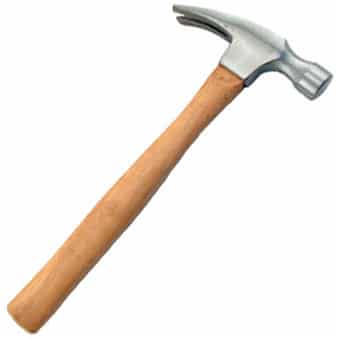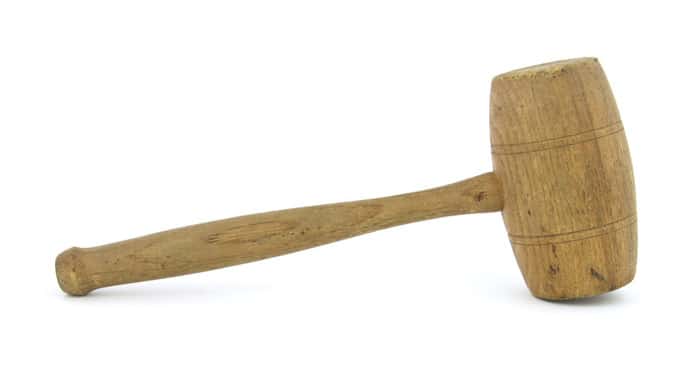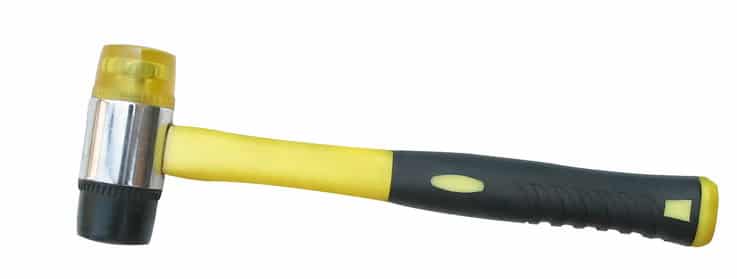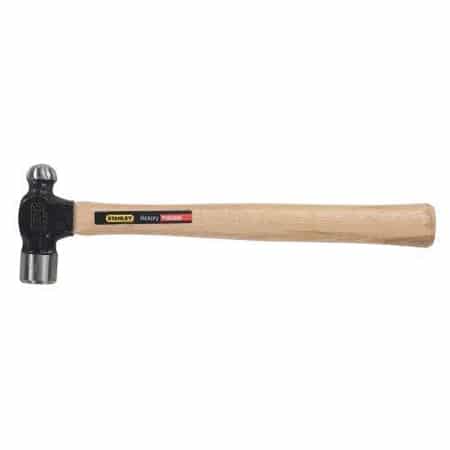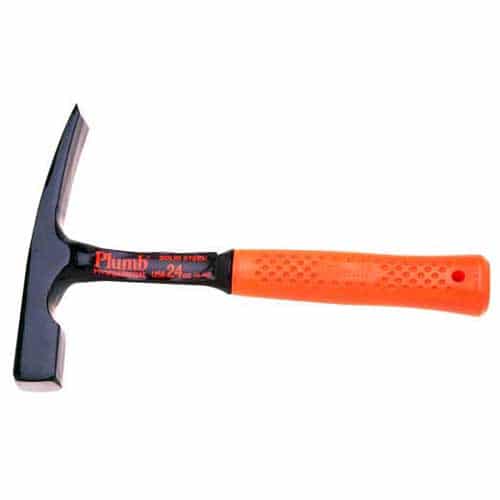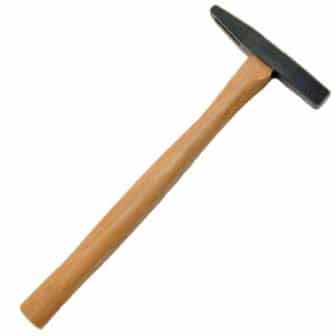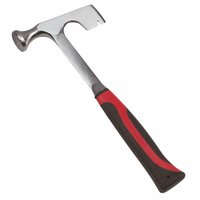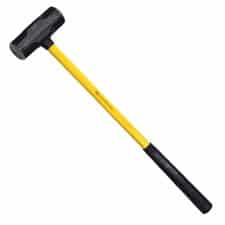Saturday, October 03, 2009
Friday, October 02, 2009
Hammer Time
I know the importance of using the right tools whenever possible and one of those tools is a hammer. This bit of wisdom comes from the AOM blog...
Toolmanship Basics: How to Handle a Hammer
Posted: 29 Sep 2009 07:57 PM PDT
A lot of men today are clueless when it comes to tools. The increased affluence of the past 50 years led many men to outsource handyman work instead of doing repairs and home improvement themselves. And let’s face it. Men today can be pretty darn lazy. They’d rather play their Xboxes than work on building something with their own bare hands.
But knowing how to handle tools is an essential skill every man should, well, have a handle on. You’ll become more self-reliant, you’ll save money, and you’ll enjoy the supremely manly satisfaction of working with your hands. To help the generation of men who never got around to learning how to use tools, we’ll be doing a series of posts on basic toolmanship.
To kick off our series on tool use, we start with the lowly hammer. To the unskilled, hammering just means pounding the hell out of something until you get the job done. Sure, you could do that, but you’ll end up with crummy results and a tired arm to boot. A wise handyman knows how to use a hammer safely, effectively, and efficiently.
Types of Hammers
Proper hammering begins with selecting the right hammer for the job. Using a hammer for tasks that it’s not suited for can result in injury and shoddy work. Below, we give you the skinny on the different types of hammers a man has to choose from.
16 ounce claw hammer. If you’ve only used one kind of hammer in your life, it’s probably this one. Its curved back makes it ideal for pulling out nails. This is a must for any man’s toolbox.
16 ounce ripping hammer. When you have a small demolition job, this is your go-to hammer. Unlike the claw hammer, the back of a ripping hammer is straight. It’s used for heavy carpentry work, framing houses, and of course, ripping crap up.
Rubber mallet. Use a rubber mallet when you hammer a finished-metal surface.
Wooden mallet. Carpenters use wooden mallets to strike wood chisels during carpentry work. Don’t try drywalling with a wooden mallet. You’ll just end up with a bunch of splinters in your face after the head smashes into a million pieces.
Soft-face hammer. When assembling furniture or working on some other decorative wood project, you need a hammer that will drive a nail without marring the surface of the wood. Go with the soft-face hammer for this job. The faces of soft-face hammers are usually made of plastic or rubber.
Ball peen hammer. Ball peen hammers are used in metalworking tasks like center punching and shaping soft metal.
Mason’s hammer. Use a mason’s hammer to cut and set bricks when laying that new walkway.
Upholster’s or tack hammer. The smaller face is designed for driving tacks in upholstery work.
Drywall hammer. The serrated face of this appropriately named hammer gives you a better grip on the nail when installing drywall. You can use its hatchet-shaped back for cutting drywall.
Huge ass sledge hammer.For big demolition jobs, bring out the big guns. Concrete, walls, and porecelin bathtubs are no match for a 10 pound sledge hammer. It also comes in handy at state fairs when attempting to win your girl a giant teddy bear.
Parts of a Hammer
Hammer Safety
Use the right hammer for the job. Don’t upholster a couch with a sledge hammer or drive drywall nails with a tack hammer. You won’t get the job done right, and you might end up injuring yourself.
Don’t strike a hardened steel surface with a steel claw hammer. Flying metal chips can injure you or a bystander.
Never use a hammer with a loose or broken handle. The hammer head could come flying off while in use. If you don’t want to explain to your wife why grandma’s china cabinet is in a million pieces, replace the handle if it’s loose or cracked.
Never use a hammer with a chipped or cracked head. It’s an accident waiting to happen.
How to Handle a Hammer
Where to hold the hammer. Hold the hammer like you’re shaking hands with somebody. When you need more control over the hammer, like when you’re starting a nail, grip the hammer closer to the hammer head. When you need power, grip the hammer near the handle’s end.
Starting the nail. Place the nail where you want to drive it and hold it between the thumb and forefinger of your non-dominant hand. Place your fingers near the top of the nail when holding it. If you hold the nail near the bottom, a missed hammer swing will crush your fingers between the wood and the hammer. Not a pleasant feeling.
Grip the hammer near the middle of the handle. Tap the nail lightly until the nail has sunk into the wood enough that it can stand on its own.
If you’re driving in nails that are too small to hold between your thumb and forefinger, use this handyman tip: Grab a piece of thin cardboard or thick paper and push the nail through it. Instead of holding onto the nail, you hold onto the cardboard. Remove the cardboard before you finish driving the nail.
For some hardwoods, it’s a good idea to drill a pilot hole before you hammer in a nail. It makes the job easier and prevents the wood from splitting. Which brings us to our next point-
Preventing wood splitting. In addition to creating a pilot hole, lubricating the nail with beeswax and blunting the nail will also keep the wood from splitting. To blunt a nail, simply tap the nail point with your hammer. Also, avoid hammering a nail into the grain of the wood.
Swing from the elbow for power; swing from the wrist for control. For maximum power and efficiency, swing from the elbow. When you need more control and finesse, swing from the wrist. Many hammer newbies try to hammer with just wrist action.
Focus on the nail, not the hammer. When hammering, you want to avoid sideways and glancing blows. To score a direct hit every time, focus on the nail head, not the hammer.
Let the weight of the hammer do the majority of the work. You don’t need to use every ounce of strength in your body when hammering. That will only lead to wild swings and bent nails. The weight of the hammer head plus your smooth swing provides enough force to get the job done.
Advanced Hammering Techniques
Clinching nails. Let’s say you drive a nail through a 2×4. The nail is longer than the board is thick, so when you drive in the nail, the nail’s point sticks through the board. You don’t want to leave those points hanging out to snag people’s clothing or scrape their skin. So you’ll want to clinch the nail. Simply strike the tip of the nail at an angle and force it down flat into the board with light taps. Sink the tip below the surface of the board with a sharp rap. When you clinch a nail, always clinch with the grain. In addition to preventing ripped shirts, clinching also lends a nail greater strength and stability.
Toenailing. When you need to nail one board perpendicular to another, like in a framing job, bust out the toenail technique. Toenailing involves driving a nail at an angle through the end of the board to anchor it to another board. To toenail, place one end of the board perpendicular to the board you want to nail it to. Drive the nail in at a 60 degree angle. It can be tricky starting an nail at an angle, so begin by making a pilot hole by tapping the nail point straight into the board. Once you have a hole, tip the nail point to the correct angle to finish driving it in. Brace your foot behind the board as you hammer, so the board doesn’t move from its spot. Toenail a second nail on the same side and two more nails on the opposite side.
Removing Nails
Claw hammers are designed to remove nails. Simply slide the claw underneath the nail head. Pull the hammer’s handle towards you to extract the nail. Here’s an old trick from grandpa to help you pull nails: Stop the first pull back before the hammer’s poll touches the surface of the wood. Place a wood block under the hammer head to provide some leverage. Using the block puts less strain on the hammer’s handle and allows you to lift the nail straight up without bending it.
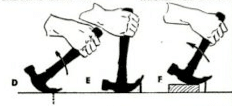 Place a block under the hammer after the first pull back
Place a block under the hammer after the first pull back
Some nail heads are too small for the tongs of the hammer to grasp. To deal with such nails, hammers are sometimes made with a small v-shaped notch in one of the prongs. If yours lacks this feature, you can simply file a v-shaped notch into one of the claws with a metal file.
Fort Wayne Site-of-the-Day

For the past week I have been featuring websites that were sent to me by a friend of mine, Tom Carroll.
Now it's his turn.
Click here to go there.
Thursday, October 01, 2009
Gmail Tips
When I first became active online, Gmail wasn't around. And then it was by invite only!
So I had free email accounts with Yahoo and Microsoft (HotMail).
When I set up my first customized domain name it was also with Yahoo. I was a strong advocate of Yahoo products.
Then, the longer I had an email address, the more cluttered with spam it became. Today estimates are that over 90% of email is spam. And Yahoo couldn't handle it. The Yahoo spam filters were catching some, but not all of the spam.
When it became overwhelming to clean out my Yahoo email every day, I began using a gmail account that I reserved and at first simply used it as a spam filter. Now with the added features that Google has added to their email program, I can send all my email into my Gmail account and all of it gets filtered!
Read more:
6 Smart Gmail Tricks To Help You Get The Most Out Of It
Posted: 11 Sep 2009 04:51 AM PDT
 I'm sure most of you would agree that Gmail has revolutionized the way we communicate and manage information via email. If you doubt it then it means that you are yet to exploit the extraordinary features of this email app to the fullest.
I'm sure most of you would agree that Gmail has revolutionized the way we communicate and manage information via email. If you doubt it then it means that you are yet to exploit the extraordinary features of this email app to the fullest.This article explores some of the outstanding Gmail features and tricks which make this tool a must have for anyone using email to communicate. The features discussed here will also help long time Gmail users to dig deeper and get the most out of this amazing service.
- Consolidate multiple email accounts into one Gmail account
This is probably the most important reason why one should make the switch if he is using a different email service. With Gmail you don't have to worry about checking your different email accounts. You can consolidate all the multiple inboxes into one Gmail account.
While the option to combine other email accounts into Gmail was always there, recently Gmail made the process a cakewalk by introducing the import option in the settings. It's super easy now to use Gmail as your one stop email service. - Learn to use filters and labels effectively
No other email service lets you filter and organize emails the way Gmail does. Using "Filters" and "Labels" in Gmail, you could always keep unimportant emails out of your inbox and be much more efficient in email management.
Here is an old but still useful article from Lifehack on ways to use Gmail filters. If you are looking to learn more about labels then this article on about.com regarding Gmail labels should help you. - Make use of multiple Gmail addresses you get with one account
This is a gem. And if you didn't know about this, here's the surprise - with Gmail you actually get an unlimited number of different email addresses. Yes, unlimited! How? Well abc@gmail.com is same as a.bc@gmail.com and abc+def@gmail.com. More on this here.
Oh, and abc@gmail.com is also same as abc@googlemail.com. Awesome feature, isn't it? This feature could be used in so many ways. Like in this article, the Digital Inspiration blog points out how you could use one email for multiple twitter accounts. That's just one use. There could be many more such tricks. Get the picture? - Use Gmail Labs
In my opinion, the next best thing the Gmail team has done after launching Gmail is introducing Gmail Labs. I wasn't gung-ho about it initially but when the different labs add-ons started rolling out, I was completely speechless. Gmail became more amazing each day.
There are a number of Labs tools you could enable. Here are my favorite picks. - Use Browser add-ons
If Firefox is your primary browser (it should be if it isn't), then you could also install certain add-ons which add more functionality to Gmail. Here is an article which talks about some of the best add-ons for Gmail available. - Make Gmail your information center
If you were to ask me the name of one person who has exploited Gmail more than anyone else, I would instantly say Steve Rubel. The man has written some great articles on how he uses the various features of Gmail to organize information efficiently. One such article is about how he transformed Gmail into his personal nerve center. It's an excellent read.
Cheers,
Abhijeet
 | Written on 9/11/2009 by Abhijeet Mukherjee. Abhijeet is an internet entrepreneur who loves writing about tech, productivity, blogging & making money online. Catch him at Jeet Blog and also subscribe to his weekly newsletter. | Photo Credit: Gubatron |
Wednesday, September 30, 2009
Be a Better Boss
Posted: 26 Aug 2009 02:41 PM PDT
 If you’re in charge of a company or team, small or large, you’ll want to do your best to keep everyone keen, engaged and productive. Being a great boss involves walking a fine line between friendship and leadership – but the rewards are immense: high employee loyalty, improved results, fewer wasted resources and the ability to go on vacation without worrying that everything will fall apart without you.
If you’re in charge of a company or team, small or large, you’ll want to do your best to keep everyone keen, engaged and productive. Being a great boss involves walking a fine line between friendship and leadership – but the rewards are immense: high employee loyalty, improved results, fewer wasted resources and the ability to go on vacation without worrying that everything will fall apart without you.The top factor in determining workplace satisfaction is the immediate manager. In a study of 60,000 exit interviews, 80% of the employees who quit their jobs did so because of their boss. (from Blame it on ‘The Boss’, BtoB Magazine)
Here are seven ways to build a great relationship with your team and to make sure that your employees stick around.
- Listen to Concerns and Grumbles
Make sure that colleagues feel you’re approachable if they have concerns. Pay attention if someone raises a perceived problem – even if your first thought is to disagree. Sometimes, the new guy or a junior employee may spot inefficiencies that you and other old hands are blind to.
Pay attention to the general office atmosphere, too. Do your employees seem dejected, unenthusiastic or stressed? Give them a chance to talk about what’s on their mind. Make changes where you can: sometimes, very small things can make a big difference in how people perceive you and their job. - Be Accessible – Sometimes
As a boss, you want to be accessible to your team. You want people to feel that they can ask your advice or admit to a mistake or a problem. The alternative is living in blissful ignorance until all hell breaks loose around you...
However, you don’t want to be too accessible, or your own work will suffer. Have a clear signal that indicates you’re not available unless it’s an emergency; closing your office door is a common and simple method. - Delegate – Then Stay Hands Off
From the employee’s point of view, there’s nothing worse than being given a task – then having constant interruptions and “suggestions” from the boss on how to accomplish it.
Learn to delegate properly – then forget about the task. Let your employee complete it in their way, without you breathing down their neck. This will considerably lighten the stress for both of you! It also helps to train people to use their initiative and work without micromanagement. - Access to Training
Try to ensure that every employee has access to training. People enjoy learning new things and feeling a sense of progression – plus, highly-trained, confident employees produce great results.
Create a corporate culture where everyone, even the most junior members, knows that they can work their way up. Don’t neglect training in a rush for quick results: it can cause problems down the line if your more experienced members of staff leave. - Update Everyone on Progress
Send out a company-wide email, or hold a short meeting, every once in a while to update everyone on the progress that’s been made recently. You’re the boss, so you have a very good picture of how all the cogs are working together to deliver significant results – but employees often only see the small part of the business that they’re involved in.
Encouraging everyone to feel part of a team effort that’s producing something worthwhile can create more satisfaction than simple monetary incentives, like pay rises. - Bring Food and Arrange Treats!
One of the most well-received things you can do as a boss is to offer “treats”. This doesn’t need to cost much – a few boxes of chocolates or packets of great cookies can be a lovely surprise treat, perhaps on a Friday afternoon.
If your team has just completed a big project or hit a significant milestone, consider arranging some sort of celebratory event – perhaps a lunch out, or an afternoon of activities. This does cost money (and person-hours) ... but it’s another big way to create the sense of being a group of friends, not just colleagues. - Say “Thank You”
This last point is a very simple one ... but it can mean so much. In the rush of day-to-day business, it’s easy to forget to acknowledge people’s hard work. But people are often much more motivated and encouraged by a few words of thanks and praise than by any other reward.
Make sure that you do thank and praise people for a job well done. Just a few words from the boss like “Joe, I heard your presentation went down really well with the clients – great work!” can make someone’s day, and it hardly costs you any time at all.
 | Written on 8/26/2009 by Ali Hale. Ali is a professional writer and blogger, and a part-time postgraduate student of creative writing. If you need a hand with any sort of written project, drop her a line (ali@aliventures.com) or check out her website at Aliventures. | Photo Credit: Kumar Appaiah |
Tuesday, September 29, 2009
Listen Up
Master the Art of Listening and Watch All Your Relationships Thrive
Posted: 24 Sep 2009 06:35 AM PDT
 No wonder listening is an undervalued art. Research shows that we speak at a rate of about 125 words per minute, yet we have the capacity to listen to approximately 400 words per minute. So what are we doing with that extra space in our minds when someone else is talking? Are we really listening?
No wonder listening is an undervalued art. Research shows that we speak at a rate of about 125 words per minute, yet we have the capacity to listen to approximately 400 words per minute. So what are we doing with that extra space in our minds when someone else is talking? Are we really listening?I have a friend who used to multi-task when we spoke on the phone. He would respond appropriately to what I was saying, but I could hear him shuffling papers or trying to quietly order food at the deli (yes, this actually happened). Even though he was following the conversation, I felt bereft as I was sharing my innermost thoughts and feelings. Fortunately, our friendship was more important than his to-do list, and now I happily get his full attention.
Listening is essential to fulfilling relationships. If you are experiencing challenging interactions or you want your connections to deepen, reflect on how you can improve your listening skills. The benefits? Consider the following:
- People will feel be more drawn to you; they will like you more.
- You will learn something new.
- You will solve problems more effectively.
- You will experience less loneliness and frustration.
- You will feel happier and more relaxed.
- Pay attention
Since our brains have the capacity to process 275 more words per minute than are actually spoken, we tend to fill up the void with extraneous thoughts. Notice how when someone is speaking, you are partially listening, while simultaneously planning the rest of your day, replaying a meeting that just occurred, or deciding what you will say next. Paying attention is the cardinal rule for good listening. Hear the words, and let their meaning in. If your mind wanders, simply re-focus your attention on the conversation. - Be receptive
If you show up with an agenda, you are not going to be available to fully hear what the other person is saying. There is no problem with having goals for an interaction, but let them go while the other person is speaking so you can hear what is being expressed. Balance your need for a given outcome with your desire to sustain a harmonious relationship. - Check your understanding
Make sure you can repeat what you just heard, and if you can't, ask for clarification. You might be surprised at how much you are missing. Most people are. When you think you've gotten it, you might say, “So what you are saying is....” to verify your understanding. - Be an explorer
Explorers are open and curious. They are inquisitive, without knowing what they will find. So what to do with all of that excess brain power? Focus on the speaker. Notice body language, tone of voice, and rate of speaking. Then look beneath the words to see what feelings and needs are being communicated. You never know what you might find. - Show interest
If you find yourself bored and distracted, reconnect with the interaction. Maintain eye contact, uncross your arms, and ask questions that take the conversation deeper. Find out what really matters to the person you are speaking with. - Be patient
As much as you may be tempted, don't speak over someone who is talking. When you feel the urge to step in, take a breath, let your agenda go, and continue to listen. If you need to move the conversation along, do so politely, as in, “Excuse me, I'm so sorry for interrupting, but ….” Likewise, be careful not to jump to conclusions or assume you know what hasn't yet been said. These are all signs that your inner explorer has fallen asleep. Revitalize your experience by paying attention to what is happening in the moment. - Get out of a rut
Have you ever had the same problematic conversation with someone over and over? Bring a fresh perspective to the relationship by redoubling your efforts to listen. Let go of your need to be right or your ideas about what the other person should be saying or doing, and hear them as if for the first time. This moves you from contraction and limit to possibility and potential simply by listening.
Effective listening develops empathy, which is the capacity for a deep understanding of another's experience. And isn't that what it takes for a relationship to thrive? It's as simple as paying attention.
 | Written on 9/24/2009 by Gail Brenner, Ph.D. Gail offers practical wisdom for clarity, freedom, and happiness on her blog, A Flourishing Life, focusing on real solutions for self-defeating habits. | Photo Credit: ky olsen |
Monday, September 28, 2009
Sunday, September 27, 2009
How I Please My Wife
Usually Kathy works all day on Sundays and usually I have dinner waiting for her when she arrives home.
Ironicly, she has today off and is going out with friends right now! However, here are a few tips from the DLM Blog:
9 Ways to Cook Lazily and Still Get Rave Reviews
Posted: 25 Sep 2009 01:37 PM PDT
 Like many people you're super busy these days. However, you appreciate the fact that eating out a lot costs a ton and frankly, it's tough to find restaurants where you completely feel at ease with the ingredients. So how do you balance this? How do you create homemade meals without spending oodles of time cooking? Clearly you'd agree that your schedule cannot tolerate hours of chopping, stirring and simmering on weeknights.
Like many people you're super busy these days. However, you appreciate the fact that eating out a lot costs a ton and frankly, it's tough to find restaurants where you completely feel at ease with the ingredients. So how do you balance this? How do you create homemade meals without spending oodles of time cooking? Clearly you'd agree that your schedule cannot tolerate hours of chopping, stirring and simmering on weeknights.Before expanding your schedule, reducing sleep, or giving into fast food demons, try using these tricks; you can turn out delicious meals with minimum effort.
- Cook from frozen
Most meats don’t need to be thawed before cooking. Boneless chicken breasts or tenders can be grilled, baked or put in the slow cooker straight from the freezer. You can even bread chicken tenders without thawing by running them under cool water to remove the ice glaze, then bread as usual. Fish fillets, such as Tilapia can also be cooked from frozen. Even roasts and larger cuts of meat can be done this way. Pop it in a pan and add the sauce or seasonings, then give them a longer cooking time. - Slow cook it
There are many excellent recipes specifically for crock pots; they aren’t just for soups and stews. Or convert your favorite dishes for use in the slow cooker. Sliding into dinner time with the food already cooked and waiting to be dished up is a satisfying feeling. - Skip the measuring
Pour a teaspoon of salt in the palm of your hand. Now try a tablespoon. Learning to eyeball measurements on herbs and spices will save you time in putting a dish together. These ingredients can be added to taste, so exactness is not necessary. - Combine Steps
Why sauté onion and garlic separate from ground beef, when you can do it all together? Why cook veggies separate from the pasta, when you can throw them into the water during the last few minutes of cooking? Fewer steps mean less time and work for you. - Skip Steps
In some recipes it’s possible to skip things such as browning meat. Yes, it might seal in the juices, but if its final destination is in a slow cooker it will be juicy enough. Skip the cracker or bread crumb toppings on casseroles and save not only time, but calories too. - Use your freezer
Cook up several pounds of chicken or ground beef on the weekends, then freeze it to use later in the week. Simmer a big pot of soup one night and freeze the rest for a quick meal later. Double that batch of muffins and pop half into the freezer. All of these tricks speed up the meal prep. - Use certain convenience items
Go for shredded cheese instead of in a block. Canned diced tomatoes taste better than most grocery store tomatoes. Better still, they are already chopped. Frozen diced onions and green peppers also save time. Instead of chopping and cooking fresh veggies for a stew or potpie, grab a bag of frozen stew vegetables. It’s not quite as good as cooking from fresh, but the difference is not enough to offset the time saved. And you get those little pearl onions in the bargain. - Choose recipes with only a few ingredients
Using only 3 or 5 ingredients is much faster than gathering and preparing a long list of things. I reject most recipes with loads of ingredients, at least for weeknight dinners. - Keep it simple
Every weekday meal doesn’t need to involve a main dish, 2 sides, bread and a dessert. Dinners like chicken fried rice or homemade nachos don’t need much to go with them. If you do need something to round out the meal, add a simple steamed veggie, tossed salad or fresh fruit.
So, how do you cook lazily? Share your tips in the comments.
 | Written on 9/25/2009 by Tiffany King. Tiffany helps busy families get dinner on the table by sharing recipes, tips and menus with complete grocery lists on her blog Eat at Home. | Photo Credit: Phu Son |
More than a Cat

Friday afternoon, my wife and I made the decision to end the suffering of one of our family members, a cat named Puddy.
It was one of the most difficult things we have had to do. We adopted him 7 1/2 years ago and he was loved by nearly everyone whom he met. Even those who were not "cat people", due to his loving nature and dog-like behavior.
The pictures I assembled represent a few glimpses from his early life through this past Thursday.


The Cat that acted like a Dog:
I always though that Puddy must have had some abandonment issues when he was young because he was less independent than most cats I had been around. Kathy was sharing with me Friday night how she remembered how when I would come home, Puddy would come to the door or come find me as if he was waiting for me to return.
A few years ago, on the 4th of July we were doing some outside work in the yard and had the cats out with us, when I think I recall, a neighbor brought him back to us and he was limping, not putting any weight on his right front paw.
He continued to walk with a limp for several years and earned the occasional nickname of Pimp Kitty!
Puddy was befriended by nearly everyone in the family and friends. He was such a gentle soul, loved being around people and would climb up in your lap just to have human contact. Because of his limp and his friendly nature everyone would ask how Puddy was and he was at times the most popular member of the family!
Sure, he did some of the typical cat things too, like chase a red laser light with fierce determination. And a couple years ago when we adopted another cat from the shelter, we saw how he would sometimes be the aggressor in their playful chasing each other through the house and wrestling.
But with people, he was always a gentle, kind soul who wanted to be where the action was.
In the evening, Kathy and I would often watch television in our bedroom which was the one room he was not allowed in. Instead he would lie on the threshold, mostly in the hallway with his head and front paws in our room.
He even put up with some innocent abuse from a young boy who was carrying him around the house and got him too close to the fireplace one winter. It wasn't until later that I noticed some singed fur that I realized what had happened.
This past year however, things began to change. We noticed that Puddy was not the fat cat anymore. He was losing weight. In March we took him to the vet and he was diagnosed with an enlarged heart and thyroid problems. He was given thyroid medicine which was a soft, chewy tablet that was almost like a treat for him twice a day.
One evening this summer we noticed that his breathing was really labored and I grew concerned about what we were going to do when he could no longer go outside because of the cold weather.
Occasionally I would even talk about him on my Twitter account, including posting some of the pictures you see here. I took him for car rides a few times and pretended that he was the one driving.

The End.
It was Thursday, just a few days ago when I noticed he was panting to breath. I learned Friday at the vet that cats, unlike dogs do not normally pant.
Thursday night was the season premier of Grey's Anatomy, a favorite show of ours, and we decided to bring Puddy into the bedroom with us, which he is normally not allowed to be in.
The show was about dealing with death of a friend and loved one and the grieving processes that different people go through. Looking back on it now, I see how this was a preparation for Friday and this weekend.
That night, Puddy did not want to eat his medicine, and I realized that he was not eating much at all the last several days. Part of my night time routine was to give him a 1/2 can of canned cat food and he was not eating it this week.
Friday Kathy left for work before me and got home before me too. When she returned home that day, she knew that this was the end. She saw Puddy laboring to breath, never complaining, continuing to be loving, wanting to be around people but barely able to survive.
At 2:30 Friday she called me to tell me she had an appointment with the vet at 4:15 and as we talked, we knew in our hearts that this was most likely going to be the last trip to the vet for Puddy.
I finished my work project and headed home, where I found Kathy and Puddy. He lifted his head to see me and then I picked him up and held him as he rested in my arms. I knew what we had to do unless the doctor could tell us he would get better, but we knew we could not prolong our cats life for our own sake.

You never realize how attached you are to your pets until you go through what we just have.
Along with my friends and family that we have talked to in person or over the phone, I also want to thank some of my Twitter friends, some of whom I have never met face to face yet who expressed their condolences.
And of course we are grateful for the past several years that we had our Puddy who was much more than a cat.

Fort Wayne Site-of-the-Day

This one I am told has a Fort Wayne connection in that the company was started by a couple of Canterbury students. Click here to go there.




